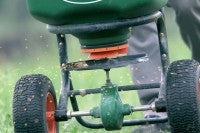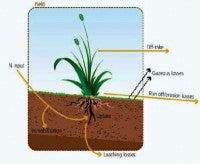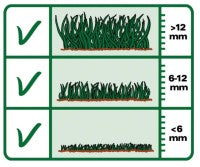Back to basics for fertiliser
 One of the most popular threads on the Pitchcare message board recently was from a member wanting help in understanding the 'basics' of fertilisers for turf.
One of the most popular threads on the Pitchcare message board recently was from a member wanting help in understanding the 'basics' of fertilisers for turf.
Because it never hurts to go 'back to basics', we enlisted the help of Stuart Staples, International Technical Manager for Scotts, to do just that in a two-part article
Part 1 - Fertilisers for turf - an introduction to N-P-K
In very general terms, fertilisers are products that improve the levels of available plant nutrients either directly to the plant or via the soil.
There are a number of nutrients that are classified as 'Essential Nutrients'. These Essential Nutrients are required by the plant in order to complete its life cycle and/or are directly involved in plant metabolism or required in a metabolic reaction.
The reason that some turf areas do not need these nutrients applied on regular basis is because they are either already present within the rootzone, or already supplied via top dressing treatments or other means. These nutrients (shown with their chemical symbol) can be classed as Macro and Micro (or trace) nutrients. Macro nutrients are needed in far higher quantities than micro nutrients, but all are equally important. If there is a deficiency of one nutrient then the plant will suffer;
Macro
• Carbon (C)
• Hydrogen (H)
• Oxygen (O)
• Nitrogen (N)
• Phosphate (P)
• Potassium (K)
• Calcium (Ca)
• Magnesium (Mg)
• Sulphur (S)
Micro (Trace)
• Iron (Fe)
• Zinc (Zn)
• Copper (Cu)
• Manganese (Mn)
• Molybdenum (Mo)
• Boron (B)
• Chlorine (Cl)
Carbon, Hydrogen and Oxygen are derived from Carbon Dioxide in the air, absorbed by the leaves, and in water, absorbed by leaves and the roots. The remaining elements are mainly taken in by the roots, but may also be absorbed by the leaves if fertilisers are applied.
What do essential nutrients do?
It is very difficult to make a definitive list of the role nutrients play in growth because they are all involved with many physiological responses within the grass plant. However, the following list highlights some of the primary functions that each nutrient is responsible for:
Nitrogen - vegetative growth, colour
Phosphate - root development and energy transfer
Potassium - plant metabolism and water regulation
Magnesium - part of chloryphyll and root growth
Calcium - cell structure, chlorophyll content (also important in soil structure)
Iron - chlorophyll constituent
Manganese - protein, N availability,
So why does turf need feeding?
The soil is the grass plant's nutrient resource and the aim is to balance the nutrients within it. The uptake and availability of certain nutrients can be restricted by excesses or insufficient quantities of other nutrients. For example, high amounts of potassium can restrict the uptake of magnesium. A soil analysis can help to determine the nutrient balance within the rootzone.
Regular maintenance is key to producing premium quality turf. When turf is mown, nutrients are removed in the clippings and must be replenished. Fertilisers assist in the production of uniform surface condition. They help keep turf healthy and aid its recovery from wear and tear. In addition to benefiting the health of the plant, they also enhance the appearance of turf. Whilst this is a long list of tasks, all are achievable with the right planning and implementation. Today's modern fertilisers have a lot to offer the turfcare professional and can play an important part in an Integrated Turf Management (ITM) programme.
What differences will I see?
The most obvious effects on turf are colour and growth. Less obvious are improved rooting, wear tolerance and drought tolerance, if the appropriate fertiliser is selected.
If I'm using fertiliser, what is a 'good result'?
Strong, healthy turf that looks good and is tolerant to various stresses (environmental and disease). For sportsturf, the surface will meet the expected playing standard.
Fertiliser types
There are lots of ways of applying nutrients to turf, it's really a case of using what works best for you on your particular turf area. Some people prefer granular applications and some prefer liquids. Many turfcare professionals use a combination of fertiliser types to achieve good growing conditions. The most ideal fertiliser programme is one that maintains consistent root and vegetative growth throughout the growing season without flushes of vegetative growth. Using Scotts products as an example, the fertiliser types available are:
• conventional release - Greenmaster Pro-Lite & Sportsmaster
• slow release (SRFs) - Sierraform GT
• controlled release (CRFs)- Sierrablen & Sierrablen Plus
• organic - Greenmaster Organic & Sportsmaster Organic
• liquid - Greenmaster Liquid
• water soluble (WSFs)- Sierrasol
In order to make an informed choice of what type of fertiliser to choose it is important to understand some of the key features/benefits of the different types.
Some fertilisers release all of their nutrients immediately after application (conventionals, liquids, WSFs). These products will produce a quick turf response in terms of colour and growth, but care should be taken as they may increase nutrient losses out of the system. These losses may be via a flush of growth (clippings removal), surface run-off, leaching or gaseous losses.
Slow release, controlled release and organic fertilisers deliver their nutrients over a certain period, with SRFs and CRFs doing this in the most consistent and reliable way. By delivering nutrients in a gradual way over 6-8 weeks (SRFs, i.e. Sierraform GT) or from 3 months up to 9 months (Sierrablen and Sierrablen Plus) then losses out of the system can be greatly minimised and nutrient use efficiency greatly improved.
Turf benefits include:
• Safe and consistent feeding
• Nutrient release based on turf need
• Efficient use of nutrients
• Environmentally friendly
• Better turf quality
The example below demonstrates how a high analysis fertiliser with CRF technology reduces nutrient loading compared to a conventional fertiliser with a low nutrient analysis.
The example below demonstrates how a CRF will reduce the number of application to turf over a certain time period compared to a conventional fertiliser. Turf quality is also improved through the use of CRF technology.
All fertilisers are not the same - what to look out for
Simply looking at the nutrient analysis of a fertiliser will only give you limited information about the product. Other factors to be aware of include:
Longevity
The longevity of a product will affect the performance (see earlier points) and also the real cost of a fertiliser. For example, a product that only needs to be applied once in a season may appear expensive compared to a fertiliser that needs to be applied four or five times when compared per kg, but is likely to be cheaper when compared over the whole season.
Granule size
The size of the granule is key for turf cut at low heights (golf and bowling greens).
Small granules are essential for dispersing into the turf sward, to avoid mower pick-up and disruption to play. It is possible to use larger granules on grass that is left longer.
Uniform granule size is important for even distribution using rotary spreaders and for blended products (not recommended for close cut turf) to ensure there is no segregation of the components in the bag or spreader.
Nutrient Source
The nitrogen source should be declared on the label. Other nutrient sources may not be.
Turf safety can be compromised by use of fertilisers high in chlorides with a high salt index - this can cause direct burning on the leaf or increase salt levels in the soil contributing to a physiological drought on the plant.
Number crunching - what do the numbers mean?
N-P-K. Depending on which country you're in, these have to be declared as oxides (UK), i.e. N, P2O5, K2O, or as Elemental i.e. N, P, K. The number that appears on the bag is % weight/weight.
So, a bag of fertiliser with analysis of 24-5-8 contains: 24% N, 5% P2O5 and 8% K2O. If your bag of fertiliser weighs 25kg, then: 6Kg N, 1.25kg P2O5 and 2kg K2O.
As this adds up to 9.25kg, you've probably wondered what other materials make up the bag. Some will be non-declarable constituents of the nutrients that are declared on the label. The remainder consists of fillers and conditioners including anti-dust and anti-caking additives and fertiliser technologies such as controlled-release coatings. Pure granular nutrients are unsuitable for turf applications because of the problem of how to safely and evenly spread nutrients across an area.
To calculate the amount of nutrients applied per area, you simply multiply the application rate (Kg/Ha) by the % nutrient content. It is standard practice to state nutrient application rate in kg/Hectare (Ha).
For example:
A 24-5-8 fertiliser with five months longevity applied at 45g/m2.
45g/m2 = 450kg/Ha
450 x 24% = 108 kg N/Ha
450 x 5% = 22.5 kg N/Ha
450 x 8% = 36 kg N/Ha
For liquids, nutrients are also declared on a % weight / weight basis. To calculate nutrients applied per application, you need to know the specific gravity or density of the liquid. A litre of water will weigh 1kg, other liquids may weigh more or less.
For example:
12-4-6 liquid fertiliser applied at 60L/Ha
Specific Gravity (SG) = 1.18 Kg/L (i.e. 1 litre of product will weigh 1.18kg)
First, calculate weight of liquid applied per Ha.
60 x 1.18 = 70.8kg/Ha
Then follow same procedure as for granules:
70.8 x 12% = 8.5 kg N/Ha
70.8 x 4% = 2.8 kg N/Ha
70.8 x 6% = 4.2 kg N/Ha
In Part 2, Stuart Staples will explain all you need to know about applying fertilisers, from timing and best practice to selecting a spreader and calibration. He'll address common problems, where to go and who to ask for advice and discuss the benefits of fertiliser programmes.
